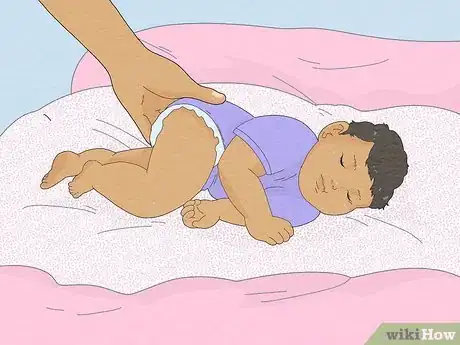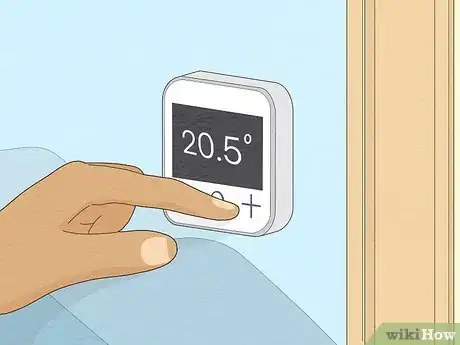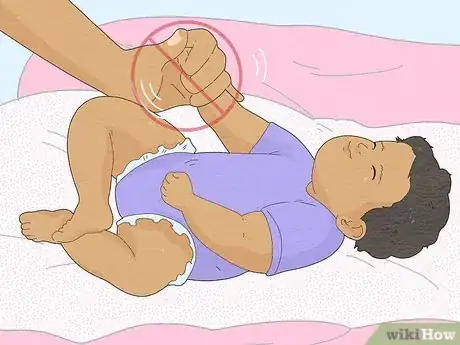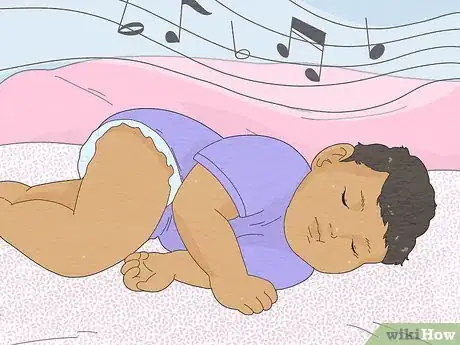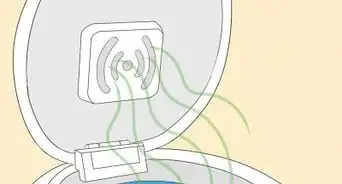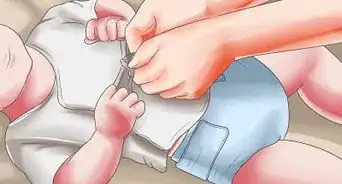This article was co-authored by Jami Yaeger. Jami Yaeger is a Parenting Specialist, Doula, and the Owner of AustinBorn, an online community offering comprehensive and modern education to growing families. With 10 years of experience, Jami specializes in whole family support for pregnancy, birth, postpartum, and parenting. Jami earned her BA in Theatre Performance from San Diego State University and earned her Certification as a Lactation Education Counselor from the University of California, San Diego. She is a Certified Infant and Child CPR Instructor, Birth and Postpartum Doula, and Childbirth Educator.
This article has been viewed 23,510 times.
Babies often cry during a diaper change. If you're trying to keep your baby happy and comfortable, you still need to change them when their diapers are soaked through or soiled. This wikiHow will help you tackle a nighttime diaper change with minimum disruption.
Steps
-
1Let your baby sleep if the diaper isn't soaked through or soiled. There's no need to change a wet diaper if it's not creating a problem during their sleep; a little wetness is unlikely to cause a rash or problem, even if they stay asleep in it for a few hours.
- Using an overnight diaper can help you avoid the need to change a sleeping baby's diaper at all; babies can often go 12 hours or more if they're wearing the right kind of absorbent diaper.
-
2Stabilize the room's temperature. Temperature changes can be a big reason why a baby may become upset when you take off their clothing to change their diaper. If the air is too cold, in particular, they may cry.Advertisement
-
3Don't actively wake your baby. They don't need to be awake during a nighttime change, if they're able to sleep through it. Just scoop them up gently and keep interactions minimal. They may stir and wake a little, but it'll be easier for them to settle back to sleep if they haven't become fully alert during the change.
- Consider changing them in their crib. The feasibility of this will depend on your setup. If possible, you might want not to move the child from their sleeping area to a diaper-changing area.
-
4Don't talk to the baby if they're asleep or sleepy. The more you communicate with your sleeping or sleepy baby, the more likely they are to stir and become upset during a change. Keep interactions minimal to send the message that it's still nighttime, and they'll be going back to sleep soon.
-
5Keep the room dark. Don't use any more lighting than you need. A red-hued or orange-hued night light is good for keeping them sleepy.[1]
-
6Keep your sound machine on. If you use calming nighttime sounds, don't turn them off during a change. Keeping the sound and light in the room as consistent as possible will help your baby stay sleepy and fall back to sleep after the change.
-
7Try calming scents in the room. Don't allow the smell of the older dirty diapers or any other unnatural scent the baby might not be used to, penetrate through the air. Lavender and chamomile smells can be used in an oil diffuser to effectively calm the baby.
-
8Complete the diaper change quickly, efficiently, and quietly. Try not to make too much noise, and get them bundled up and comfortable again as quickly as possible. Then place them back in their crib and, if possible, let them get back to sleep on their own. If they've woken up too much, you may need to repeat whatever routine you usually use to get them to fall asleep.
Community Q&A
-
QuestionCan I just leave your baby in a 12-hour diaper?
 Community AnswerIf your baby is soiling the diaper frequently, no.
Community AnswerIf your baby is soiling the diaper frequently, no.
